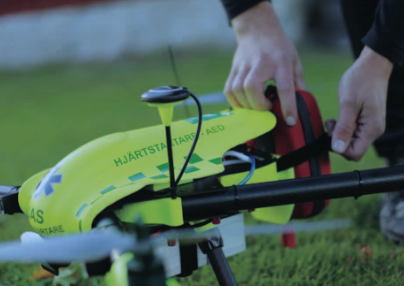Having life-saving technology available is one thing. Getting it to where it's needed is another – especially when just a few extra minutes of wait time can mean the difference between life and death.
This is especially true when it comes to automated external defibrillators, which are used to restore the heart to it's normal rhythm when someone goes into cardiac arrest. If this device, also known as an AED, can be deployed quickly damage to the heart can greatly minimized.
However, when the victim isn't near a hospital, firehouse, open school or other medical facility – where the AEDs typically are – every minute without one is crucial.
That's where delivery-oriented technology can immensely improve a heart victim's chances of survival, according to a new research letter from Swedish researchers at the Karolinska Institute in Stockholm that was published Tuesday in the Journal of the American Medical Association.
Creating a study using actual ambulance response times from 18 past heart-attack incidents that occurred away from access to medical services near Stockholm, a team of doctors and nurses reported that dispatching GPS-enabled drones to the same locations was faster in every case – with a median reduction in response time by 16 minutes an 39 seconds.
These incidents were termed out-of-hospital cardiac arrest, or OHCA, events.
 "The drone arrived in less time than the EMS in all simulated cases," the authors wrote in the research letter, which noted its 8-rotors and a "maximum cruising speed, 75 km/h," or 46.5 miles per hour. "Therefore, drones carrying AEDs may reduce time to defibrillation in OHCAs. Saving 16 minutes is likely to be clinically important."
"The drone arrived in less time than the EMS in all simulated cases," the authors wrote in the research letter, which noted its 8-rotors and a "maximum cruising speed, 75 km/h," or 46.5 miles per hour. "Therefore, drones carrying AEDs may reduce time to defibrillation in OHCAs. Saving 16 minutes is likely to be clinically important."
The American Heart Association reports that in 2016 more than 350,000 people in the United States suffered an OCHA event, with just a 12 percent "survivor rate," meaning that those victims made it to a hospital for treatment before being released.
Since every minute saved is significantly consequential, the impact drone-delivered AED packs can have on victims' survivability is literally life-altering. The adjacent photo shows an AED attached to a dispatched drone (photo courtesy: author Andreas Claesson, RN, PhD, et al).
"Using an AED to shock the heart within minutes of the start of SCA [sudden cardiac arrest] may restore a normal heart rhythm," according to the National Institutes of Health. "Every minute counts. Each minute of SCA leads to a 10 percent reduction in survival."
And AEDs can be used by virtually anyone. They are easy to operate and don't require any training, eliminating the requirement of having an EMT at hand.
"Sticky pads with sensors (called electrodes) are attached to the chest," as the NIH explains on its website. "The electrodes send information about the person's heart rhythm to a computer in the AED. The computer analyzes the heart rhythm to find out whether an electric shock is needed. If a shock is needed, the AED uses voice prompts to tell you when to give the shock, and the electrodes deliver it."
The Centers for Disease Control and Prevention report that roughly 735,000 Americans suffer a heart attack each year, with 525,000 of those experiencing one for the first time. If you're interested in learning more about how AEDs work or are used, here's some additional information provided by the Mayo Clinic.

